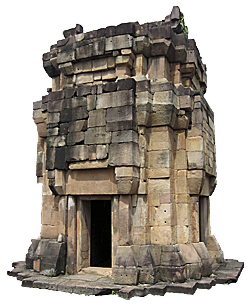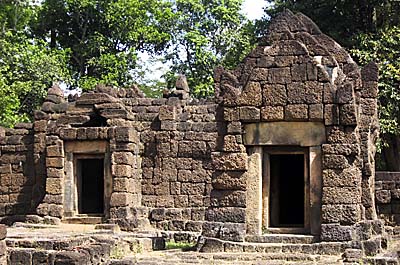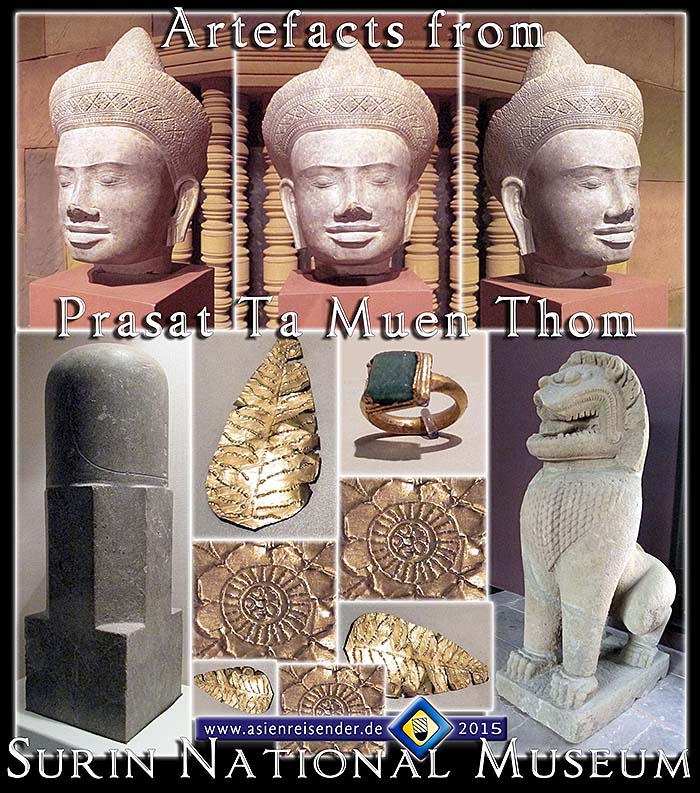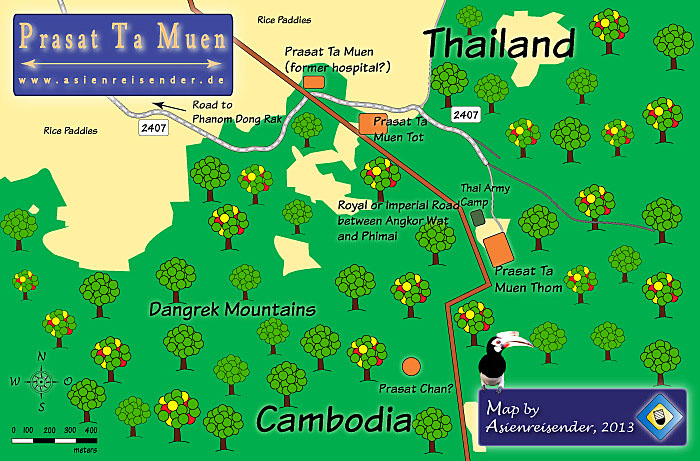
Prasat Ta Muen / Prasat Ta Meuan
At a very remote spot in Thailand's Surin Province at the very border to Cambodia are three small remains of Angkorean buildings to find. Coming from the next village in Thailand, Phanom Dong Rak, where the last bus stop is placed, a lonely road leads one some ten kilometers south into the jungle. The first site one reaches is Prasat Ta Muen, which looks like a chapel with an intact roof and a hall inside.
A Hospital Chapel

Prasat Ta Muen. This building which looks like a christian chapel might have served as a hospital along the royal Angkorean road between Angkor Wat and Phimai. Image by Asienreisender, 2010
Short behind that, on the right side of the road follows Prasat Ta Muen Tot, consisting of the remains of three old Khmer temples with former prangs. The third and last site is Prasat Ta Thom, five building remains who are situated directly at the border. The three sites date back to approximately the 11th and 12th century CE.
The Prasat Ta Muen buildings are placed at one of the passes over the Dangrek Mountains. It was built along the imperial (or royal) Angkorean road which connected Angkor Wat with Phimai. It served as a resthouse with a connected hospital for the travellers of the time.
Very few tourists make the way to Prasat Ta Muen.
In the 1980s Khmer Rouge troops were hidden in the surrounding forests and also the ruins. They did a great damage to the ancient sites, including the usage of explosives. They removed lintels and other stone engravings to sell them out.
In the early 1990s the road from Phanom Dong Rak was built from the Thai side approaching the ancient ruins.
Since the border here is under dispute, on both sides are military troops stationed. At the very end of the road from the Thai side there is a Thai military camp. Which line exactly the border is following remains unclear, the border markers have been removed. The official border would be that drawn between French Indochina and Siam in 1907.
A Laterite Sidebuilding

A sidebuilding at Prasat Ta Muen Thom. Image by Asienreisender, 2010
Shootings between the both sides appear occasionally. A bigger combat happened on April 22nd, 2011, in which four Thai soldiers and three Cambodian soldiers were killed, and another eight Thai injured. Both sides used artillery and thousands of Thai villagers were evacuated from twenty surrounding villages.
Besides, the surrounding jungle is heavily mined - that one can call the 'cultural heritage of the Khmer Rouge'.
It is to say here that the site is in good hands under Thai supervision. Everywhere in Thailand the Thai Fine Arts Department does a really good job to preserve the cultural heritage in the country. Prasat Ta Muen has been restorated in 1991 and the following three years.
Prasat Ta Muen Thom

Part of Prasat Ta Muen Thom. The site is a hidden pearl in the forest. Image by Asienreisender, 2010
Artefacts from Prasat Ta Muen Thom

The National Museum in Surin houses a collection of what the archeologists found when researching and restorating the site. Alas, the comments on the artefacts are very scant. The head is an 11th century piece representing the Baphuon style of the time. The linga left dates back to the 12th century and is already Angkor Wat style. The gold ring is Lopburi style, 11th century as the leaf gold as well. The lion is not that clearly to date and could belong to any of the both times. All images and photocomposition by Asienreisender, 10/2015
Map of Prasat Ta Muen

A map of the three sites of Prasat Ta Muen. A few hundred meters further south in the Cambodian forest might be another site, Prasat Chan?! Another few hundred meters further southeast there might have been a barray (Khmer water basin, no more on the map).
It's possible to reach the place by bus from Surin. It's a longer trip (around two hours, depends on the waiting times for the busses; the bus has to be changed once on the way) and requires to start relatively early, because the last bus back goes quite early.